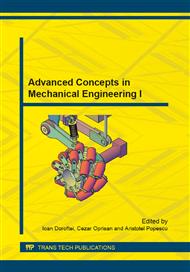p.612
p.618
p.626
p.632
p.638
p.644
p.648
p.654
p.660
Method and Software for Analyzing the Assembly/Disassembly Operations of Mechanical Products
Abstract:
Enrolling in the current trends of using collaborative virtual environments and virtual reality techniques for engineering applications, the current paper presents the synthetic results of a research in which an innovative method and software application were developed for analyzing and simulating the Assembly/Disassembly (A/D) operations of mechanical products. Starting from the 3D CAD model of an assembly and using connection interface and mobility operator concepts, the application supports the designers in generating valid A/D plans by determining the interfaces between components, calculating the components mobility and identifying the functional role of components in an assembly. Thus, the developed software provides designers an automated tool for analyzing A/D operations, obtaining and simulating A/D sequences, useful in the design phase of a mechanical product, for training the operators, as well as for improving the productivity of activities such as recycling, maintenance and reusing. Moreover, the application was conceived so that, in a further step, to be integrated in an immersive environment, offering a realistic simulation in two modes of interaction: free mode and kinematically guided. Finally, in order to validate the proposed methods and concepts, the application was tested for evaluating users’ satisfaction degree.
Info:
Periodical:
Pages:
638-643
Citation:
Online since:
October 2014
Authors:
Price:
Сopyright:
© 2014 Trans Tech Publications Ltd. All Rights Reserved
Share:
Citation:


